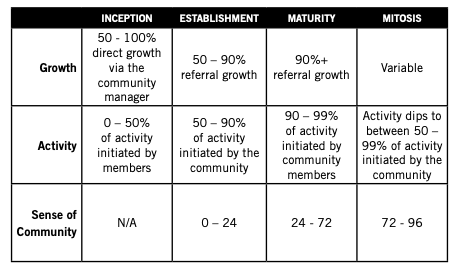The term Community Management get’s a more and more important topic in the field of online marketing. But do you really know how to build up a community, how much time you should spend for what and that responding to unsatisfied users is not the most important thing in this field?
Because of a lecture to this topic at my master's Content Strategy at the FH Joanneum I did some research and started reading the book: Buzzing Communities: How To Build Bigger, Better, and More Active Online Communities by Richard Millington, which gave me a lot of interesting insights.
The thing about data
How do you want to value your work without it?
In all topics of content marketing data has a big importance, but not in Community Management. But why? Richard Millington wrote in his book about a huge mistake in his first Job of Community Management, where he did not take time for generating data and also did not know that you should do that. After this experience he noticed, why this is so important, because:
- you don’t know if your work is good or not
- you don't know what impact your work has on the ROI of the company

Don't look after the minority
When everyone thinks it has to be like that
For me it was clear, a community manager is here to look what happens, what the community is writing and to react when there are upcoming discussions which maybe could escalate. After only reading the first chapter of this book, which I have mentioned above, I have noticed how the process of community management has to look like.
For me it was very interesting, that not only I am thinking like that, but there is a phenomenon that community manager set their focus on those people in the community who always have a problem with something. But when it takes about one hour to satisfy them again, what would you do if there are five people you have to work on?
Therefore, it is very important to not only keep focus on the loudest ones in the community but on the majority. Because as Richard wrote: “What’s a better use of your time, responding yet again to a disgruntled member or organizing an event members will be excited about?”
How to manage your community?
8 important activities in Community Management
Before explaining how the community manager should build up the process to establish a good-working community I want to show you the eight most important activities - copied from Richard Millingtons Book - a manager has to work on.
- Strategy. establishing and executing the strategy for developing the community.
- Growth. Increase membership of the community and convert newcomers into regulars.
- Content. Create, edit, facilitate, and solicit content for the community.
- Moderation. Remove obstacles to participation and encourage members to make contributions.
- Events and activities. Create and facilitate events to keep members engaged.
- Relationship and influence. Build relationships with key members and gain influence within the community.
- Business integration. Advocate internally within the organization and integrate business processes with community efforts.
- User experience. Improve the community platform and participation experience for members.

The four phases of strategy
From building up to dividing again
With these four steps Millington shows how to strategically build up a community.
1. Inception
- This phase is the starting point. It starts with interacting with the audience and inviting new one until you reach the critical mass, the moment where it run's itself.
2. Establishment
- This step begins when the audience has reached the critical mass and the community manager can start working on major tasks like writing content, organizing events, resolve conflicts and much more.
3. Maturity
- Step three is reached when the community is generating at least 90% of activity, but when there is no real community-feeling. When this sense is reached, the community is in the last step of this process – the Mitosis.
4. Mitosis
- In this phase the level of community sense is plateaued and there is no possibility for further growing. There comes the decision, are there niche topics which could be divided, so a new community emerges or is it already a very specific topic and the community should stay as it is.

My experiences
Ok wow – there is still a lot to learn about Community Management
After reading this book I noticed how less information I had about this whole process and how important it is to have a strategy also in community management and especially to work with data.
In the company where I am currently working at, we established a Facebook group for hiking inspiration about two years ago – because it was a trend to open a Facebook Group. We only did some examples of what we could do in step one of Community Management and the community grew a little bit. Due to the fact that we did not really focused on this Facebook group the further development was not that important for us.
Due to my lecture I also read a few other articles about some of my colleagues which are very interesting:
- Linda wrote about the connection of Community Management and resilience
- Barbara has a very interesting post about humanity and authenticity in Community Management
To sum it up, as now the user opinion, as well as the user generated content and everything about users gets more and more important, I am delighted that I got a little bit more into the literature of community management and looking forward to your examples and experiences.

Kommentar schreiben